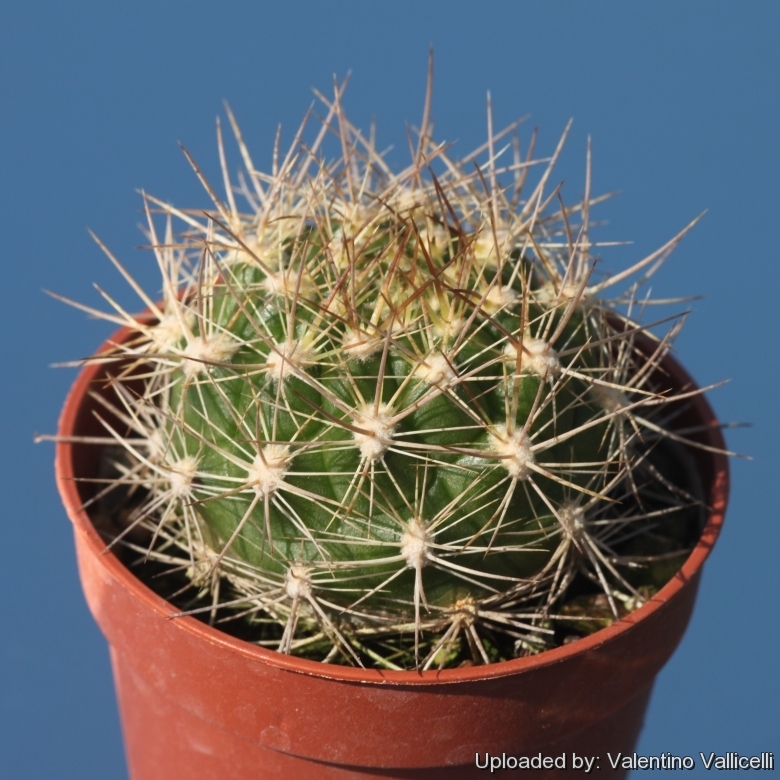Donate now to support the LLIFLE projects.
Your support is critical to our success.
Your support is critical to our success.
Accepted Scientific Name: Rebutia neocumingii
Bradleya 5: 94 (1987)

Weingartia hajekyana Photo by: Valentino Vallicelli
KK1156 (Collector Karel Kníže) Mairana, Bolivia. Altitude: 1300m.
KK1156 (Collector Karel Kníže) Mairana, Bolivia. Altitude: 1300m.
Synonyms:
See all synonyms of Rebutia neocumingii
back
Accepted name in llifle Database:Rebutia neocumingii (Backeb.) D.R.Hunt
Bradleya 5: 94 (1987)
Synonymy: 67
- Rebutia neocumingii (Backeb.) D.R.Hunt
- Bridgesia cumingii (Hopffer) Backeb.
- Echinocactus cumingii Hopffer
- Echinocactus cumingii Regel & E.Klein bis
- Gymnantha cumingii (Hopffer) Y.Itô
- Gymnocalycium cumingii (Britton & Rose) Hutchison
- Gymnorebutia neocumingii (Backeb.) Doweld
- Hildmannia cumingii (Hopffer) Kreuz. & Buining
- Lobivia cumingii (Hopffer) Britton & Rose
- Spegazzinia cumingii (Hopffer) Backeb. in Backeb. & F.M.Knuth
- Weingartia cumingii (Hopffer) Backeb. & Oosten
- Weingartia neocumingii Backeb.
- Rebutia corroana Cárdenas
- Gymnocalycium pulquinense var. corroanum (Cárdenas) Hutchison
- Gymnorebutia pulquinensis subs. corroana (Cárdenas) Doweld
- Sulcorebutia corroana (Cárdenas) Bredero & Donald
- Sulcorebutia neocorroana F.H.Brandt
- Weingartia corroana (Cárdenas) Cárdenas
- Weingartia pulquinensis var. corroana Cárdenas
- Rebutia neocumingii subs. lanata (F.Ritter) D.R.Hunt
- Sulcorebutia lanata (F.Ritter) F.H.Brandt
- Weingartia lanata F.Ritter
- Rebutia neocumingii subs. pulquinensis (Cárdenas) D.R.Hunt
- Gymnocalycium pulquinense (Cárdenas) Hutchison
- Sulcorebutia pulquinensis (Cárdenas) F.H.Brandt
- Weingartia pulquinensis Cárdenas
- Weingartia attenuata F.H.Brandt
- Weingartia brachygraphisa F.H.Brandt
- Weingartia buiningiana F.Ritter
- Gymnorebutia buiningiana (F.Ritter) Doweld
- Weingartia columnaris F.H.Brandt
- Weingartia erinacea F.Ritter
- Sulcorebutia erinacea (F.Ritter) F.H.Brandt
- Weingartia erinacea var. catarirensis F.Ritter
- Weingartia gracilispina F.Ritter
- Weingartia hajekyana
- Weingartia hediniana Backeb.
- Gymnorebutia hediniana (Backeb.) Doweld
- Sulcorebutia hediniana (Backeb.) F.H.Brandt
- Weingartia neocumingii var. hediniana (Backeb.) Donald
- Weingartia knizei F.H.Brandt
- Weingartia knizei var. bruneispina Kníže
- Weingartia longigibba F.Ritter
- Sulcorebutia longigibba (F.Ritter) F.H.Brandt
- Weingartia lanata subs. longigibba (F.Ritter) Donald
- Weingartia neocumingii var. longigibba (F.Ritter) K.Augustin & Hentzschel
- Weingartia mairanana (Donald) F.H.Brandt
- Gymnorebutia pulquinensis subs. mairanensis (Donald) Doweld
- Weingartia neocumingii var. mairanana (Donald) A.B.Lau
- Weingartia neocumingii var. mairanensis Donald
- Weingartia pulquinensis var. mairanensis (Donald) Pilbeam
- Weingartia mataralensis F.H.Brandt
- Weingartia matoralensis Kníže
- Weingartia multispina F.Ritter
- Gymnorebutia neocumingii subs. multispina (F.Ritter) Doweld
- Sulcorebutia multispina (F.Ritter) F.H.Brandt
- Weingartia neocumingii var. multispina (F.Ritter) Donald
- Weingartia neglecta F.H.Brandt
- Weingartia neocumingii var. koehresii Oeser
- Weingartia neocumingii var. neglecta F.H.Brandt
- Weingartia neocumingii f. prolifera hort.
- Weingartia pruinosa hort.
- Weingartia saetosa F.H.Brandt
- Weingartia sp. KA381 Icla, altitude 2630m
- Weingartia sucrensis F.Ritter
- Sulcorebutia sucrensis (F.Ritter) F.H.Brandt
Rebutia neocumingii subs. pilcomayensis (Cárdenas) D.R.Hunt
Cactaceae Consensus Init. 4: 8. 1997 [Oct 1997]
Synonymy: 7
- Rebutia neocumingii subs. pilcomayensis (Cárdenas) D.R.Hunt
- Sulcorebutia pilcomayensis (Cárdenas) F.H.Brandt
- Weingartia lanata subs. pilcomayensis (Cárdenas) Donald
- Weingartia pilcomayensis Cárdenas
- Weingartia platygona Cárdenas
- Sulcorebutia platygona (Cárdenas) F.H.Brandt
- Weingartia lanata f. platygona (Cárdenas) Donald
Rebutia neocumingii subs. riograndensis (F.Ritter) D.R.Hunt
Cactaceae Consensus Init. 4: 8. 1997 [Oct 1997]
Synonymy: 5
- Rebutia neocumingii subs. riograndensis (F.Ritter) D.R.Hunt
- Gymnorebutia riograndensis (F.Ritter) Doweld
- Sulcorebutia riograndensis (F.Ritter) F.H.Brandt
- Weingartia lanata subs. riograndensis (F.Ritter) Donald
- Weingartia riograndensis F.Ritter
Rebutia neocumingii subs. saipinensis (F.H.Brandt) D.R.Hunt
Cactaceae Consensus Init. 4: 8. 1997 [Oct 1997]
Synonymy: 2
- Rebutia neocumingii subs. saipinensis (F.H.Brandt) D.R.Hunt
- Weingartia saipinensis F.H.Brandt
Rebutia neocumingii subs. trollii (Oeser) D.R.Hunt
Cactaceae Consensus Init. 4: 8. 1997 [Oct 1997]
Synonymy: 4
- Rebutia neocumingii subs. trollii (Oeser) D.R.Hunt
- Gymnorebutia neocumingii subs. trollii (Oeser) Doweld
- Weingartia neocumingii var. trollii (Oeser) Donald
- Weingartia trollii Oeser
back
| Your Actions | |
|---|---|
| Back to Weingartia index | |
| Back to Cactaceae index | |
 |
Back to Cacti Encyclopedia index |








